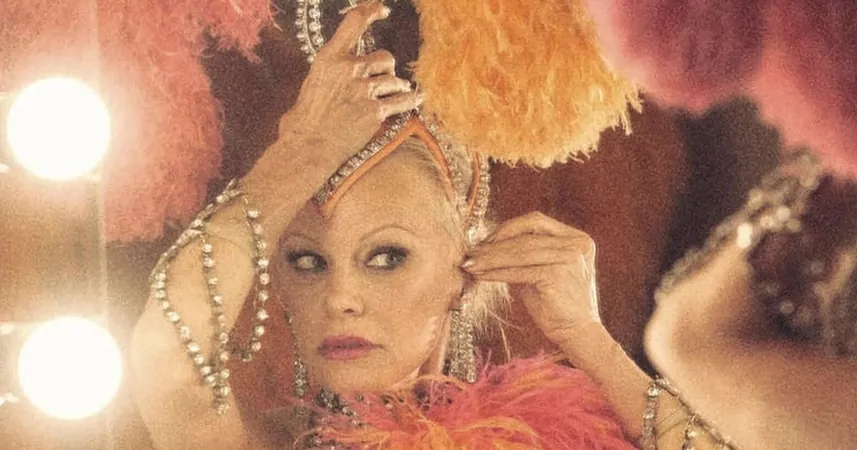
Pamela Anderson Shines in ‘The Last Showgirl’: A Heartfelt Farewell to an Era
2025-01-08
Author: Ken Lee
Pamela Anderson Shines in ‘The Last Showgirl’: A Heartfelt Farewell to an Era
In a dazzling display of talent and emotion, Pamela Anderson takes center stage in Gia Coppola's poignant new film, “The Last Showgirl.” Portraying Shelly, a seasoned performer on the brink of retirement, Anderson’s haunting performance brings to life the struggle of a woman facing the twilight of her career in a disenchanted Las Vegas. Draped in shimmering sequins and adorned with elaborate feathered headdresses that evoke the elegance of a bygone era, Shelly symbolizes an age that is slowly fading away.
As the narrative unfolds, we witness Shelly and her fellow performers grapple with the devastating news that their beloved show, aptly titled Le Razzle Dazzle, will close its curtains for good. For Shelly, who passionately cherishes the theatrical world—“the costumes, the sets, being bathed in that light night after night”—this announcement is more than just job loss; it signifies the end of her identity as a performer.
Shot with a grainy 16mm aesthetic, lending a dreamy quality to the film, “The Last Showgirl” invites viewers to intimately experience the camaraderie among a group of women navigating the unpredictable waters of life and art. Alongside Anderson, we meet a diverse array of characters, including younger dancers Jodie (Kiernan Shipka) and Mary-Anne (Brenda Song), as well as Annette (Jamie Lee Curtis), a retired dancer turned cocktail waitress who plays a pivotal role, expertly injecting humor and depth into the narrative.
As Shelly’s relationship with her estranged daughter Hannah (Billie Lourd) adds a layer of familial conflict, the stark reality of aging and the fleeting nature of fame loom large. Shelly finds herself in auditions where the brutal truth rings out—“someone younger, someone better”—forcing her to confront the harshness of an entertainment industry that often overlooks women her age.
While the storyline may not lead to a definitive resolution for Shelly, the film is a tapestry of relatable moments: women finding joy in each other’s company, celebrating their love for performance, and sharing laughter amidst uncertainty. One standout scene showcases the transformative power of dance, as Curtis’s character delivers an impromptu performance that encapsulates the unrecognized artistry present in their lives.
Anderson rises to the occasion, delivering a poignant representation of a woman caught between nostalgia for her past and an uncertain future. Her portrayal of Shelly is both sweet and haunting, infused with a determination that resonates with anyone who has ever faced similar crossroads in life. In her feathery costumes and wistful dialogue, Shelly captures a sense of beauty and value that transcends the superficial judgment of others.
As the film emphasizes themes of resilience, sisterhood, and the pursuit of artistic passion in the face of societal neglect, “The Last Showgirl” ultimately serves as a bittersweet elegy to an art form that deserves recognition. For those who appreciate nuanced storytelling interwoven with heartfelt performances, Pamela Anderson’s compelling showcase is not to be missed.
Embrace the magic of “The Last Showgirl”—a film that proves that while eras may end, the artistry and passion of performers never truly fade away.

 Brasil (PT)
Brasil (PT)
 Canada (EN)
Canada (EN)
 Chile (ES)
Chile (ES)
 Česko (CS)
Česko (CS)
 대한민국 (KO)
대한민국 (KO)
 España (ES)
España (ES)
 France (FR)
France (FR)
 Hong Kong (EN)
Hong Kong (EN)
 Italia (IT)
Italia (IT)
 日本 (JA)
日本 (JA)
 Magyarország (HU)
Magyarország (HU)
 Norge (NO)
Norge (NO)
 Polska (PL)
Polska (PL)
 Schweiz (DE)
Schweiz (DE)
 Singapore (EN)
Singapore (EN)
 Sverige (SV)
Sverige (SV)
 Suomi (FI)
Suomi (FI)
 Türkiye (TR)
Türkiye (TR)
 الإمارات العربية المتحدة (AR)
الإمارات العربية المتحدة (AR)